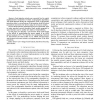Free Online Productivity Tools
i2Speak
i2Symbol
i2OCR
iTex2Img
iWeb2Print
iWeb2Shot
i2Type
iPdf2Split
iPdf2Merge
i2Bopomofo
i2Arabic
i2Style
i2Image
i2PDF
iLatex2Rtf
Sci2ools
94
Voted
FDTC
2009
Springer
2009
Springer
Low Voltage Fault Attacks on the RSA Cryptosystem
—Fault injection attacks are a powerful tool to exploit implementative weaknesses of robust cryptographic algorithms. The faults induced during the computation of the cryptographic primitives allow to extract pieces of information about the secret parameters stored into the device using the erroneous results. Various fault induction techniques have been researched, both to make practical several theoretical fault models proposed in open literature and to outline new kinds of vulnerabilities. In this paper we describe a non-invasive fault model based on the effects of underfeeding the power supply of an ARM general purpose CPU. We describe the methodology followed to characterize the fault model on an ARM9 microprocessor and propose and mount attacks on implementations of the RSA primitives.
Related Content
| Added | 26 May 2010 |
| Updated | 26 May 2010 |
| Type | Conference |
| Year | 2009 |
| Where | FDTC |
| Authors | Alessandro Barenghi, Guido Bertoni, Emanuele Parrinello, Gerardo Pelosi |
Comments (0)

